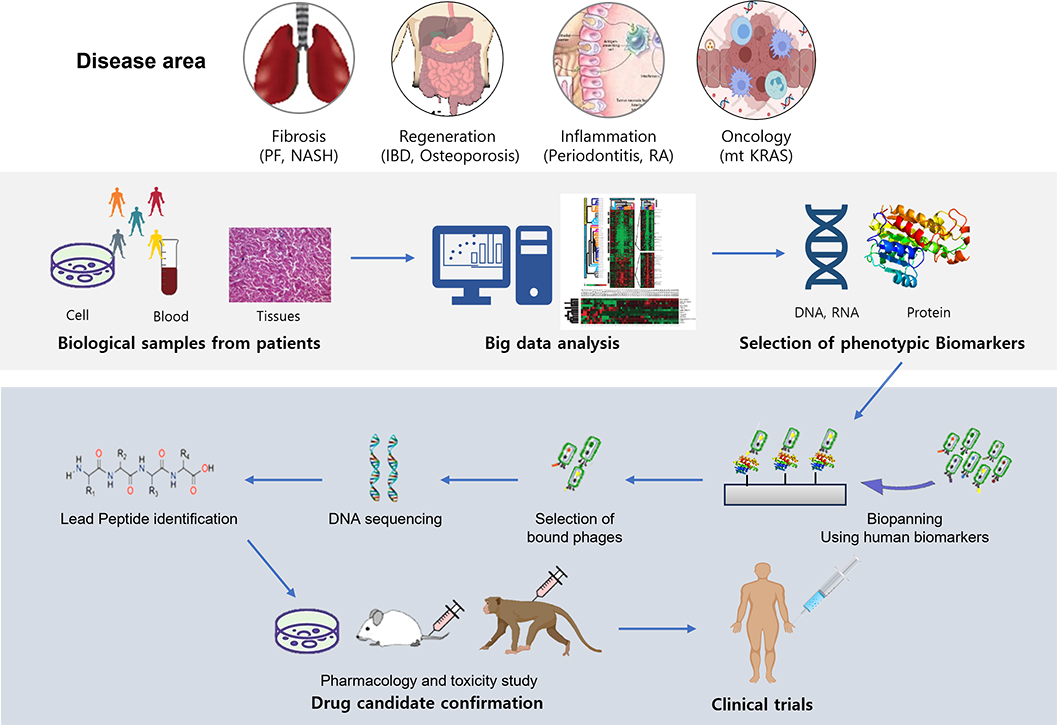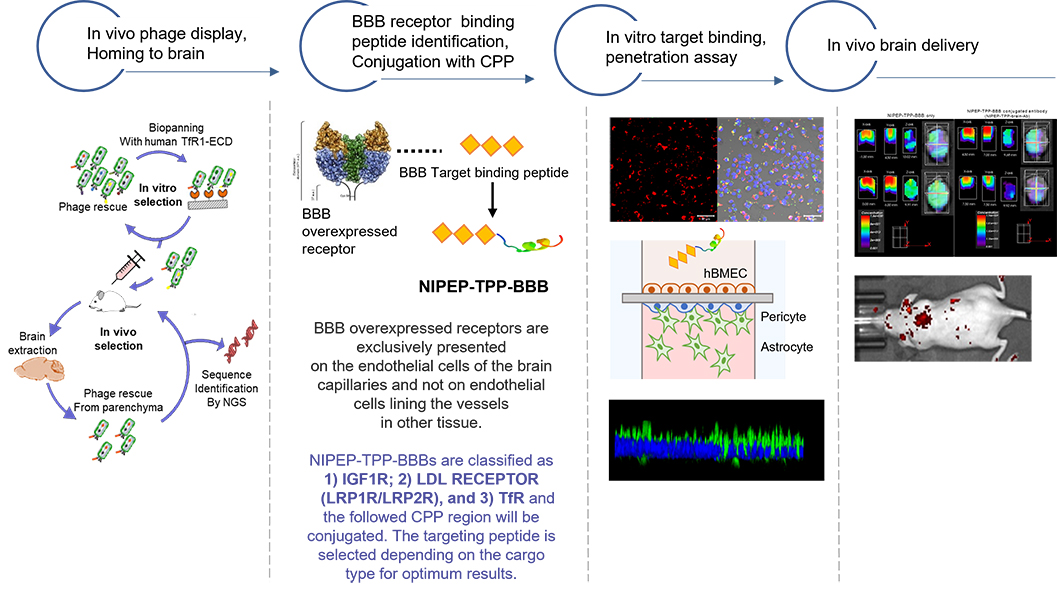R&D
Core Technology
 > R&D > Core Technology
> R&D > Core Technology
1 Peptide discovery technology (PEPscovery)

The bioactive peptide was identified by Peptide discovery (PEPscovery) platform technology. The biosamples such as blood or tissues from patients were collected and find selective biomarkers in biosamples using big data platform. The bioactive peptide that can interact with selective phenotypic biomarkers was identified by phage display method. The in vitro and in vivo repeated bio panning discovered highest binding phages and resultant highest affinity peptide. The isolated peptide was chemically synthesized, then efficacy and safety were tested to confirm the bioactive peptide as therapeutic candidate.
2 NIBEC Cell Penetrating PDC (Peptide Drug Conjugate)

NIBEC’s technology is based on a unique peptide-delivery carrier, NIPEP-TPP (NIBEC PEPtide as Target Penetrating Peptide). This target-selective cell-penetrating carrier consists of three sections: a cell-penetrating peptide; a linker that can be joined to a cargo drug; and a targeting moiety peptide. Consequently, NIPEP-TPPs enable the creation of peptide-drug conjugates (PDCs) that, depending on the targeting moiety, can be selectively delivered to almost any specific cell or tissue with high efficiency and safety.
3 Identification of targeting/homing peptide

The team in NIBEC's biologic facility is able to identify targeting moieties via in vitro/in vivo phage display. They can then prepare moieties and cell-penetrating peptides in a one-stop peptide synthesis, and produce NIPEP-TPPs fused with therapeutic cargos that target specific cells and tissues, including in the liver, lung, bone, brain, muscle, and immune system.
4 Anti-cancer effect of NIPEP-TPP based anti-mutant KRAS antibody

NIBEC is applying its PDC concept to various indications, including oncology. For example, the company is developing an NIPEP-TPP anti-mutant KRAS antibody that binds the G12C mutant form of human KRAS protein expressed in some lung cancers. Normally, the large size of an anti-KRAS antibody prevents it from penetrating cells, but joining it to NIPEP-TPP enables the antibody to penetrate the target cell, where it can bind mutant KRAS to decrease cancer growth. NIPEP-TPP anti-KRAS antibody decreased size of orthotopic lung cancer and increased survival rate.
5 NIPEP-TPP-BBB shuttles identification

By targeting blood-brain barrier (BBB) receptors, NIPEP-TPP technology can also be used to ferry therapeutics across the BBB, offering hope to patients with notoriously difficult-to-treat Alzheimer’s disease, glioma, and other central nervous system (CNS) disorders. BBB-overexpressed receptors are exclusively presented on the endothelial cells of the brain capillaries and not on endothelial cells lining the vessels in other tissue, resulting in better delivery by the BBB-penetrating NIPEP-TPPs. Once the targeting peptide of our NIPEP-TPP-BBB interacts with one of these receptors, the CPP enables penetration, after which the cargo drug is moved to other regions by transcytosis
6 In vivo BBB delivery of NIPEP-TPP-BBB / siRNA and β-catenin

To delivery of RNA drugs, NIPEP-TPP-BBB forms a double layer nanocomplex preventing enzymatic attack during the circulation, resulting in 60-70% loading efficiency and effective gene knock down at various region of brain including cortex, midbrain, and cerebellum.
7 The benefit of NIPEP-TPP based PDC

The benefit of NIPEP-TPP based PDC is that NIPEP-TPP is safe and effective compared to Lipid nanoparticles (LNP). LNP can increase anaphylaxis and level of IFN-α and IL-12 cytokine. The toxicity in major organs and ADA response was not observed upto 100mg/kg when IV/SC injected into mice.

